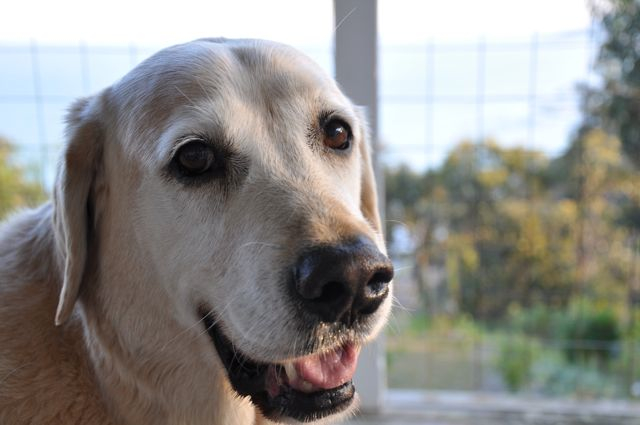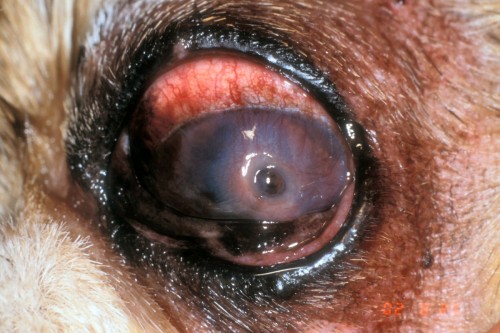ecently Dr Chris went out to see Nelson, the 12 year old Labrador Retriever. His owner rang Chris as Nelson had a weepy eye and the tissue around his eye was also a bit red. Nelson seemed quite bothered by his sore eye and was pawing at it.
On examination Dr Chris was suspicious of a corneal ulcer and undertook thorough eye examination. A special stain, fluorescein, which is applied directly to the eye as drops, was used to show the area of the ulcer on the corneal surface. When an ulcer is present the fluorescein dye is taken up into the defecit area and looks green.
Corneal ulcers are seen in dogs and cats when the surface layer of the eye (the cornea) is damaged. The cornea is the front clear part of the eye which protects the inside structures of the eye and allows light to enter the eye. It is usually a perfectly smooth surface and bacteria and debris cannot stick to it. Normal blinking wipes the cornea clean with the aid of tears. If the cornea becomes damaged and the surface becomes roughened (a corneal ulcer) this can cause bacteria to stay on the surface of the eye causing discomfort and inflammation.
Dogs and cats often show signs of increased tear production and tear overflow, squinting, blinking more frequently and sometimes a loss of clarity to the eye surface. The eye is often red and may have sensitivity to light.
There are many possible causes of corneal ulcers including
- Trauma, blunt or penetrating (including from rough play with other animals)
- Disease
- Tear deficiency
- Infection
- Can not close the eyelids completely
- Paralysis of facial nerve
- Foreign body
- Burns from a chemical substance
Some breeds have a predisposition to eyelids rolling inwards (entropion) which may lead to corneal ulceration.
Some corneal ulcers are superficial or shallow and will heal within 3-4 days however when they are deeper they take longer to heal and can become complicated.
Most simple corneal ulcers will respond quickly to treatment however some may require procedures to assist the healing of the cornea.
In Nelson’s case Dr Chris went to check on him a few days later. At the re-visit his ulcer had decreased in size but was still present. Golden Retrievers (and Boxers & Corgi’s) are more likely to have slow healing or indolent ulcers. These often require a ‘freshening’ up of the surface of the eye to organise the healing process. This procedure may require sedation or anaesthetic but in some cases can be performed with local anaesthetic.
Nelson received some anti-inflammatory tablets and an eye ointment and was scheduled for a re-visit. If his ulcer has not significantly improved at the next visit he will be booked in to have the procedure to improve the healing.


“Some breeds have a predisposition to eyelids rolling inwards (entropion) which may lead to corneal ulceration.”

